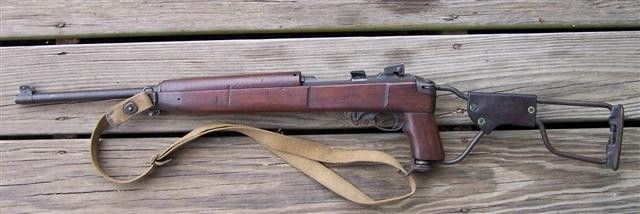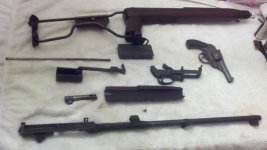I'm with Kraig on this.
I'm sure many people here have seen the articles, read the published accounts, heard the vet stories etc
I do a little US militaria collecting myself, and the climate of 1945 (and earlier in the US involvement) was such that yeah sure, you'd get in trouble for a 'lost' rifle say, in training. They'd make you pay for it out of your
pay. Today it's a major, major deal and the rifle
will be found or accounted for and there's big major penalties. I hear that Leavenworth is still around. But that wasn't the climate in WWII, and especially if nobody knew it was 'lost', such as a battleground pick-up. To support that, there's plenty of documented stories of soldier using a weapon they picked up. In WWII, a GI was
not assigned a specific s/n rifle. if you turned in an M1A1, it didn't have to be 'the same one' as the one you were issued.
Look at the stories of the Normandy invasion. Guys abandoned their rifles in water over their heads and picked up weapons on the beach. Nobody said 'gotcha' about the lost original rifle. the only thing that stopped a GI from mailing home a rifle- especially one like an M1A1 (mine fits in a pillow case, fully assembled with a mag!) would be the desire and opportunity. And most troops were not on the front lines, so there was plenty of opportunity. Look at the guy who mailed home a jeep, or photographs of the third reich that were mailed home. I could disassemble my M1A1 completely and make it fit into a tube of fairly small diameter. It seems really easy to get that M1A1 to the homefront in WWII if a guy had the chance. And naturally, he wasn't getting permission. Also plenty of stories of guys who had weapons with them in their duffel bags, heard that things like this were being confiscated in say, New York, and said 'to hell with it, I'm not ditching that stuff', kept them, and didn't get searched after all
Personally, I strongly believe that the guys who did the fighting have no moral issues with 'stealing' those rifles or pistols. They paid for them dearly. I believe in law and if that is contradictory to my earlier statement then fine, I contradict myself. I am large, I contain multitudes. And Uncle Sam didn't really pursue legal action. Heck, my Model of 1911 is blued and reads "United States Property". Was it a DCM sale? Was it a lunchbox special? Did somebody mail it home from France in 1918? I dunno, but nobody ever got in trouble over it. Try that with an M9 today....
The single best well documented WWII M1A1 came up a few years back. American Rifleman did an article. Was picked up by a non-paratroop because it fit nicely inside his jeep. It was a pick-up, and it turns out it was well documented. that's the preferred thing today for a buyer or for discussion of course
But does that mean that
without the verifiable story, the rifle
cannot have been a vet bring-back? Respectfully, it just means that it can't be documented. If grandpop used the thing in WWII, and sent it home and it's been there ever since, well, we can assume that the rifle did not
grow there in the closet, regardless of paperwork or the lack thereof

Let's look at some details on this rifle. I own one, a non-verifiable M1A1 of course. Inland, arguably the right s/n range.
Depending on what's been done to the M1A1 in question, we know some things.
One it has flip up rear sights. contrary to popular belief, the windage adjustable was not a strictly post-WWII item. neither was a bayo lug front band. Quite unlikely to find these items on a WWII example, but neither of these features are on the rifle in question
The type of stock and handguard can tell us things- high wood? Two rivet handgaurd? Don't know, and while not conclusive, it could suggest things. If highwood and two rivet and the rifle s/n supports the first contract, then we can tend to feel it could be a bring-back. can't conclusively make proof but it can lend itself to a scenario
The stock can tell us things. as mentioned, High wood, etc. Cartouches? if they have all been sanded off, and the name 'Jimmy' is still there, it could mean that somebody was afraid of getting caught with USGI property. or it could mean that the stock was arsenal refinished and somebody carved it up later. However, 'highwood' wouldn't survive an arsenal refinish
So, the rifle itself can tell us many things, because of what was done or was not done by Uncle Sam. The only thing it can't do is speak and tell us if it's an original, and unless some Inland records are discovered that prove s/ns in each case, collectors are in a band unless the rifle is documented
rangerryder:
A wealth of info is known about this type of rifle. can you post some specifics? Such as:
Maker of the rifle. Only Inland originally made M1A1 carbines.
The s/n range. Just the first three digits followed by 'XXXXXX' would be good enough
Photos of any markings that were USGI stamped on the stock. Pay close attention to the handgrip area, too
Photos overall would help in discussing this rifle. Even the shape of the grip is informative, and if it has a parkerized round bolt, that tell a story, too





